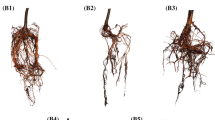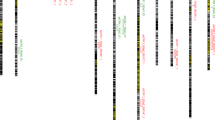Abstract
The inheritance of resistance to Xylella fastidiosa (Xf), the bacterium which causes Pierce’s disease (PD) in grapevines, was evaluated within a factorial mating design consisting of 16 full-sib families with resistance derived from Vitis arizonica interspecific hybrids. Measurements of disease progression under greenhouse conditions were based on quantitative assessment of Xf populations in stem tissues and on three phenotypic scores: leaf scorch, a cane maturation index (CMI) and an index that incorporated shoot stunting into the cane maturation index (CMSSI). Measurement of bacterial populations yielded the highest broad-sense heritability for resistance on a genotype mean basis (0.97), indicating that this measure of resistance was the least effected by environmental variation. Narrow-sense heritability of PD resistance was moderately high and measured 0.52, 0.60, 0.63 and 0.37 for Xf populations, CMI scores, CMSSI scores and leaf scorch values, respectively. Complex segregation analysis using the computer program Statistical Analysis for Genetic Epidemiology (sage) strongly indicated the existence of a major gene for PD resistance, which accounted for 91% of the total genetic variance. Conversion of the quantitative data into qualitative resistance levels and evaluation via a chi-square analysis showed that 15 of the 16 families segregated in accordance with a single gene hypothesis with a dominant allele controlling PD resistance. These data indicate that the trait should be relatively easy to pass on from parents to progeny in a breeding program for the development of PD-resistant grape cultivars, particularly when selection is based on cane maturation scores or stem Xf populations.


Similar content being viewed by others
References
Bailey LH (1934) The species of grapes peculiar to North America. Gentes Herbarum 3:154–244
Bonney G (1984) On the determination of major gene mechanisms in continuous human traits: regressive models. Am J Med Genet 18:731–749
Butler O (1910) Observations on the California vine disease. Mem Torrey Bot Club 14:111–153
Comeaux BL (1991) Two new Vitis Vitaceae from mountainous Mexico. SIDA Contrib Bot 14:459–466
Comstock RE, Robinson HF (1952) Estimation of average dominance of genes. In: Gowen JW (ed) Heterosis. Iowa State University Press, Ames, pp 494–516
Cousins P, Walker MA (2002) Genetics of resistance to Meloidogyne incognita in crosses of grape rootstocks. Theor Appl Genet 105:802–7
Elston R, Masmboodril K, Glueck C, Fallat R, Tsang R, Leuba V (1975) Studies of the genetic transmission of hypercholesterolemia and hypertriglyceridemia in a 195 member kindred. Ann Hum Genet 39:67–87
Esau K (1948) Anatomic effects of the viruses of Pierce’s disease and phony peach. Hilgardia 18:423–482
Falconer DS, Mackay T (1996) Introduction to quantitative genetics. 4th edn. Longman Group, Edinburgh
Fehr WR (1991) Principles of cultivar development—theory and technique, vol 1. Iowa State University Press, Ames
Goodwin PH, Purcell AH (1992) Pierce’s disease. In: Flaherty DP (ed) Grape pest management. Division of Agriculture and Natural Resources, University of California, Oakland, CA, USA, pp76–84
Guevara J (1997) Occurrence of Pierce’s disease (Xylella fastidiosa) in grape of the Guadalupe Valley, Baja California, Mexico. Phytopathology 87:S36
Halbrooks MC, Mortensen JA (1989) Origin and significance of Florida hybrid bunch grapes and rootstocks. Hortscience 24:546–550
Hallauer AR, Miranda JB (1988) Quantitative genetics in maize breeding, 2nd edn. Iowa State University Press, Ames, IA, USA
Hanson WD (1963) Heritability. In: Hanson WD, Robinson AF (eds) Statistical genetics and plant breeding. Publ no. 982 NAS-NRS, Washington, D.C.
Hewitt WB (1958) The probable home of Pierce’s disease virus. Plant Dis Rep 42:211–214
Hewitt WB, Frazier NW, Houston BR (1942) Pierce’s disease of grapevines. Calif Agric Exp Sta Circ 353:1–32
Hopkins DL (1989) Xylella fastidiosa xylem-limited bacterial pathogen of plants. Annu Rev Phytopathol 27:271–290
Hopkins DL, Purcell AH (2002) Xylella fastidiosa: Cause of Pierce’s disease of grapevine and other emergent diseases. Plant Dis 86:1056–1066
Hopkins DL, Thompson CM (1984) Seasonal concentration of the Pierce’s disease bacterium in ‘Carlos’ and ‘Welder’ muscadine grapes compared with ‘Schuyler’ bunch grape. HortScience 19:419–420
Hopkins DL, Mollenhauer HH, Mortensen JA (1974) Tolerance to Pierce’s disease and the associated rickettsia-like bacterium in muscadine grape. J Am Soc Hortic Sci 99:436–439
Jarvik G (1998) Complex segregation analyses: uses and limitations. Am J Hum Genet 63:942–946
Krivanek AF, Walker MA (2005) Vitis resistance to Pierce’s disease is characterized by differential Xylella fastidiosa populations in stems and leaves. Phytopathology 95:44–52
Krivanek AF, Stevenson JF, Walker MA (2005) Development and comparison of symptom indices for quantifying grapevine resistance to Pierce’s disease. Phytopathology 95:36–43
Loomis NH (1958) Performance of Vitis species in the south as an indication of their relative resistance to Pierce’s disease. Plant Dis Rep 42:833–836
Lu J, Cousins P (2003) Field evaluation of grape rootstock response to natural infection by Pierce’s disease. In: Pierce’s Dis Res Symp. Coronado, Calif., pp19–22
Lynch M, Walsh B (1998) Genetics and analysis of quantitative traits. Sinauer Assoc, Sunderland
Milholland RD, Huang PY, Clayton CN, Jones RK (1981) Pierce’s disease on muscadine grapes in North Carolina USA. Plant Dis 65:73–74
Mortensen JA (1968) The inheritance of resistance to Pierce’s disease in Vitis. J Am Soc Hortic Sci 92:331–337
Munson TV (1909) Foundations of American grape culture. Orange Judd Company, Denison, Tex.
Nyquist WE (1991) Estimation of heritability and prediction of selection response in plant populations. Crit Rev Plant Sci 10:235–322
Raju BC, Goheen AC, Teliz D, Nyland G (1980) Pierce’s disease of grapevines in Mexico. Plant Dis 64:1981
Wiggins IL (1980) Flora of Baja California. Stanford University Press, Stanford
Acknowledgments
We gratefully acknowledge research funding from the California Department of Food and Agriculture PD Board, the American Vineyard Foundation, the North Coast PD Task Force and the Louis P. Martini Endowed Chair Funds. Scholarship support to AFK from the following sources is also gratefully acknowledged: the American Society for Enology and Viticulture, the American Wine Society Educational Foundation, the James Beard Foundation and the André Tchelistcheff Foundation. The CSA results of this paper were obtained by using the program package sage, which is supported by a U.S. Public Health Service Resource Grant (RR03655) from the National Center for Research Resources. The authors also thank Rong Hu for help with ELISA; Andrew Skinner, Dan Ng, Sainey Ceesay and Luis Paat for assistance with plant care; David Neal and Debra Skinner for their valuable review of this manuscript.
Author information
Authors and Affiliations
Corresponding author
Additional information
Communicated by O. Savolainen
Rights and permissions
About this article
Cite this article
Krivanek, A., Famula, T., Tenscher, A. et al. Inheritance of resistance to Xylella fastidiosa within a Vitis rupestris × Vitis arizonica hybrid population. Theor Appl Genet 111, 110–119 (2005). https://doi.org/10.1007/s00122-005-1999-3
Received:
Accepted:
Published:
Issue Date:
DOI: https://doi.org/10.1007/s00122-005-1999-3




